The Best Aviation MRO Software
We tested and reviewed the top aviation MRO software on the market and reviewed our favorites below.
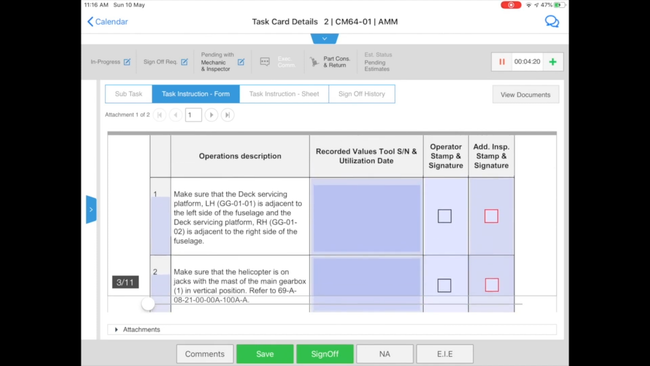
- Advanced reporting capabilities and allows exporting data to Excel
- Users have reported excellent customer support
- Integrated platform that includes several modules
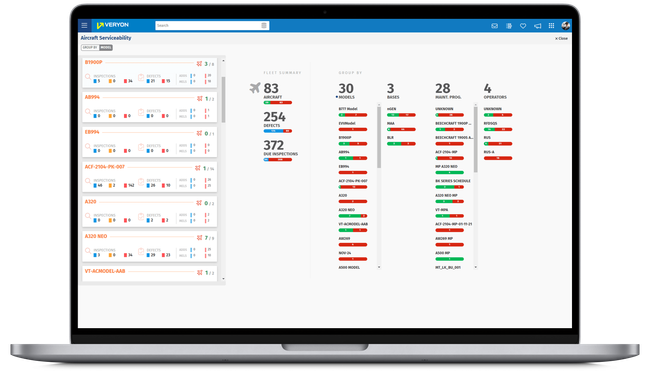
- Integrates with other systems like SAP
- Single solution for multiple functions
- Allows for adoption of paperless maintenance
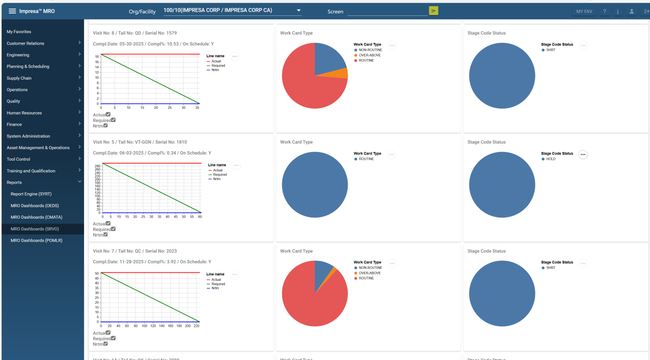
- Offers several integrated MRO modules
- Steamlines maintenance operations and financial cash flow
Aviation MRO software enables companies to streamline and optimize their aircraft maintenance operations. We used our review methodology to review and rank our favorites.
- Ramco: Best Overall
- Veryon: Best for OEMs
- Impresa MRO: Best for Full Service MRO
- Traxxall: Best for Business Jet Operators
- Component Control: Best for Air Carriers
- Smart145: Strong Mobile Support
- OASES: Best for CAMOs
- Aircraft Maintenance Systems(AIR22): Best for Military Aviation
- CORRIDOR: Best for FBOs
Ramco - Best Overall
Ramco is an ERP software that covers aviation MRO, supply chain control, financial management, and global payroll. While the Ramco ERP system covers everything needed to run an aviation enterprise, its real differentiator is its Aviation Suite, a platform built specifically for MROs, airlines, and operators.
The MRO suite is the operational core of Ramco’s platform, bringing engineering, maintenance, and materials management into a single connected system. Engineering teams can create multi-level sub-assemblies for complex parts, while maintenance teams can update aircraft records, part inventory, and organize work schedules. This ensures that everyone has access to what is happening, if parts are available, and the time it takes to replenish them. Instead of teams operating independently, every decision is now taken with complete confidence.
Because Ramco includes a complete package from logistics to HR and finance, it is best for larger organizations that can benefit from tightly connected workflows. Its learning curve and enterprise pricing may be too steep for smaller operations with minimal complexity in their supply chains. That said, quotes typically reflect its enterprise scope and require a consultation for pricing details.
Learn more about the Ramco Suite here: Ramco Aviation Review.
Veryon - Best for OEMs
Veryon delivers a strong maintenance tracking and work order management module for OEMs. With a clear, color-coded interface, you can check open work orders, statuses, and approvals, all from the maintenance calendar. Plus, this aviation maintenance software even links your work orders to inventory requests and procurement, so you’ll always have the right parts on hand.
The system takes the guesswork out of maintenance by auto-generating work orders based on usage data and manufacturer recommendations. So, if you need to plan ahead, you can schedule servicing around aircraft availability. But if technicians spot an issue during inspections, they can submit a Non-Routine to log it instantly. From there, your supervisors can add it to scheduled maintenance or create a new work order if it requires separate servicing.
Additionally, Veryon supports electronic sign-offs, so your techs and inspectors can digitally verify completed tasks. This ensures all the critical steps and documentation, like parts used and safety checks, are in place before final approval. The sign-off is then time-stamped, recorded, and stored as a part of your work order history for compliance with OEM warranties and legal requirements.
Impresa MRO - Best for Full Service MRO
Impresa MRO is built for aviation service providers that manage multiple types of maintenance operations. Its MRO platform can support heavy airframe checks, component repairs and overhauls, tear downs, and part harvesting, as well as parts sales and reselling. This makes it a strong option for full-service MROs that have work spanning across several shops or departments.
Impresa’s unified structure helps manage these operations from a single system. It standardizes how work moves from initial inspection to final sale. The software tracks and serializes every tool, component, and sub-assembly throughout the process, ensuring compliance with the FAA, DOD, and other regulatory agencies. This not only supports traceability but also keeps work orders, inspections, and documents linked together as they transition from airframe checks to component repairs or teardowns. And because this data flows through a central platform, planners can see details like material availability and employee capacity in real-time, making scheduling complex work easier.
Impresa works best for full-service MROs that require tight coordination across multiple shops or production areas. Smaller repair stations with more focused services may find the platform more than they require. Pricing is quote-based and offered as a simple monthly subscription. Impresa offers self-hosted deployment and does not require hefty upfront license fees like other enterprise-level platforms.
Traxxall - Best for Business Jet Operators
Traxxall delivers advanced tracking capabilities with built-in templates for over 400 models of fixed-wing and rotary-wing aircraft from manufacturers like Bombardier, Gulfstream, and Hawker. Its customizable dashboards and screens help operators adapt and personalize the system to meet their specific workflows or maintenance schedules.
Each of Traxxall’s clients receives direct peer-to-peer support from aviation analysts and A&P mechanics who have worked on aircraft themselves. These analysts perform aircraft enrollment and assist with ongoing operations, ensuring that all data is accurate from the start. This helps minimize aircraft downtime and contributes to operational savings by maintaining reliable maintenance forecasts.
However, Traxxall wouldn’t be a great fit for commercial airline operations as it’s designed for private and corporate aviation. Instead, its strengths lie in configurable maintenance management, deep OEM templates, and personalized customer support.
Component Control - Best for Air Carriers
Component Control’s core product, Quantum Control, provides features that manage the entire MRO process. This includes shop control, repair order management, publications tracking, barcoding, and mobile technician access, which can help air carriers streamline their operations.
This aircraft maintenance software provides visibility into exceptions, such as part shortages, cost overruns, and schedule slips. This helps carriers maintain regulatory compliance and ensure quality management. Quantum Control is also installed in over 60 countries and can be deployed as a single-site or multi-national solution, making it a suitable choice for aviation companies with global operations.
However, some users have mentioned that although Component Control has impressive capabilities, it may have some unnecessary features, and new users face a steep learning curve.
Smart145 - Strong Mobile Support
Smart145 offers a customer portal and mobile app for iOS and Android. These allow aviation technicians to manage their operations seamlessly when on the go or working in the hangar.
With the customer portal, clients can view service details, invoices, and quotes with just a click. Smart145 also incorporates advanced capabilities like automated task scheduling, real-time collaboration, and intelligent data analysis. These features enable data-driven decision-making and optimize workflows. However, users have mentioned that Smart145 can be costly to purchase, customize, and maintain.
OASES - Best for CAMOs
OASES provides a suite of modules that cover different aspects of MRO operations, such as maintenance planning, scheduling, inventory management, and warranty management. There is also a dedicated airworthiness module that maintains detailed data on aircraft configurations, airworthiness directives, service bulletins, and component life cycles.
OASES has a cloud-based repository for storing and managing aircraft technical records digitally. This can ensure compliance with regulatory requirements by maintaining up-to-date records. The software also manages issues related to repetitive defects, reliability, and trends for a compliant maintenance program.
The software can integrate with flight schedules, electronic flight bags, electronic tech logs, and e-enabled aircraft data feeds for short-term maintenance planning. However, given the number of features OASES offers, new users may require significant training.
Aircraft Maintenance Systems(AIR22) - Best for Military Aviation
Aircraft Maintenance Systems (AMS) delivers compliance management, inventory control, and service bulletins through its AIR22 MRO platform. It also ensures compliance with military regulations, such as those set by the FAA and DoD.
AIR22 can track parts and tools, minimizing downtime and maintaining readiness in military aviation. The software also automates tasks like tracking service bulletins and airworthiness directives and generates compliance reports to ensure that military aircraft are maintained according to the latest guidelines.
CORRIDOR - Best for FBOs
CORRIDOR can manage the full range of FBO processes, from amenities to fuel sales and concierge services. The system also features time-tracking capabilities, as well as quoting, invoicing, and compliance for aircraft serviced at the FBO.
This aviation MRO software includes paperless e-signature support to comply with regulatory standards. It also offers specific configuration forms, such as FAA and EASA, to comply with aircraft maintenance standards. The system features a bi-directional data flow between maintenance providers and aircraft operators to maintain compliance.
CORRIDOR allows service centers to accurately track who uses specific repair and maintenance tools for each task. This can help with labor cost tracking and billing for maintenance work and aid in managing personal qualification records to ensure techs are properly certified and trained for their work. However, CORRIDOR may have a steep learning curve for new users and smaller organizations. Proper training and support are required to navigate the system confidently.
What Is Aviation MRO Software?
Aviation MRO software is an aircraft maintenance, repair, and overhaul solution. These systems, often called maintenance, repair, and operations, provide maintenance tracking, inventory management, and flight operation functionalities for a fully integrated flight department management option.
This type of maintenance software is used by any business involved in the maintenance, repair, and overhaul of planes, helicopters, and aviation parts. These MRO companies streamline airplane fleets’ maintenance, engineering, and logistics, and can be used by maintenance directors, inventory parts managers, flight schedulers, dispatchers, and even C-level executives.
Aviation MRO software is responsible for aircraft airworthiness. Engineering directors must ensure compliance with maintenance activities, while logistics managers must source the right spare parts. Advanced forecasting features can plan maintenance, manage work orders, carry out material management, create and distribute purchase orders, and manage warranty replacement.
Any company implementing an aviation MRO solution will aim to improve its organization’s logistics, engineering and planning, maintenance, production, and quality assurance control.
MRO: Operations or Overhaul?
We are often asked if MRO stands for Maintenance, Repair, and Overhaul or Operations. The confusion comes from how the acronym is used across industries.
-
In aviation, MRO officially stands for Maintenance, Repair, and Overhaul, covering everything from routine checks to complete rebuilds of engines or major components.
-
In manufacturing, fleet, and facilities management, some vendors use MRO to mean Maintenance, Repair, and Operations, focusing more on keeping equipment running smoothly rather than performing deep overhauls.
When we talk about aviation MRO software, we are referring to systems built for the aviation definition, platforms that manage every phase of maintenance, repair, logistics, and compliance.
These solutions typically include key features such as:
Key Features
- Inventory Management: Manage the parts you need for maintenance purposes and monitor inventory costs to stay within budget. View available parts in a catalog, put in requests for items, create purchase orders, monitor prices between vendors, record physical inventory counts, and handle cycle counts.
- Maintenance Tracking: Manage the aviation business’s predictive and preventative maintenance. With maintenance tracking, you can scan equipment data for performance trends and use condition-based monitoring to alert the appropriate staff of potential issues.
- Maintenance Scheduling: Create schedules, track procedures, set maintenance routines, and balance workloads. Includes line maintenance, hangar maintenance, shop maintenance, engine maintenance, tool management, dent and buckle work, and employee time tracking.
- Supply Chain Management: Optimize and view a product or spare parts’ entire lifecycle. Key features include parts administration, supplier management, warehouse management, procurement, material planning, repairs and exchanges, scrap management, and receiving goods.
- Work Order Management: Create a trackable document identifying what aircraft maintenance work needs to be done and how it should be accomplished. Key features include rules-based approval management, scheduling management, change orders, and reporting.
- Compliance Documentation: Ensure compliance with aviation regulatory standards such as the FAA, EASA, and CAAC to maintain a legal airworthiness status. Manage certificates, logbooks, and maintenance documentation with digital sign-offs and audit trails.
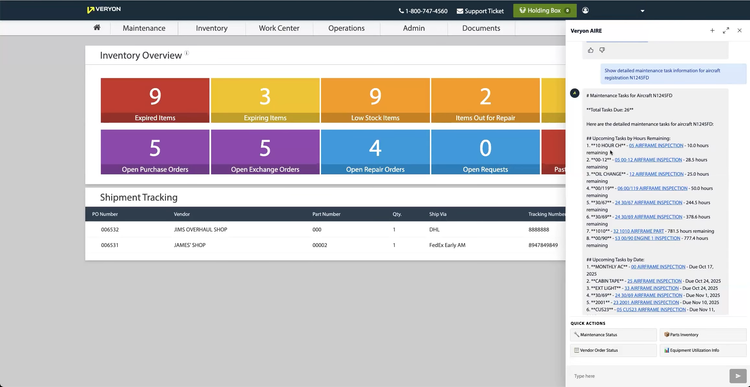
Benefits
Some of the top benefits of aviation MRO software include:
Ensure Aircraft Reliability, Durability, and Safety
Whether commercial or military, maintaining the safety and reliability of an airline fleet depends on a product’s availability, reliability, and quality. When these new parts, materials, and structural concepts are implemented via maintenance programs, safety and reliability measures should be taken care of. Proper preventive maintenance ensures no deterioration process occurs and can provide your business with the needed information for when a design modification needs to happen when inventory is not available.
Proper MRO software will provide both structural and component maintenance. Structural maintenance for aircraft will assess fatigue and damage tolerance. Component maintenance will take care of hardware items that wear out, meaning parts will be removed from service once they reach a certain level of use or a period of time has passed. Many components will have this measure of deterioration and be removed for periodic maintenance.
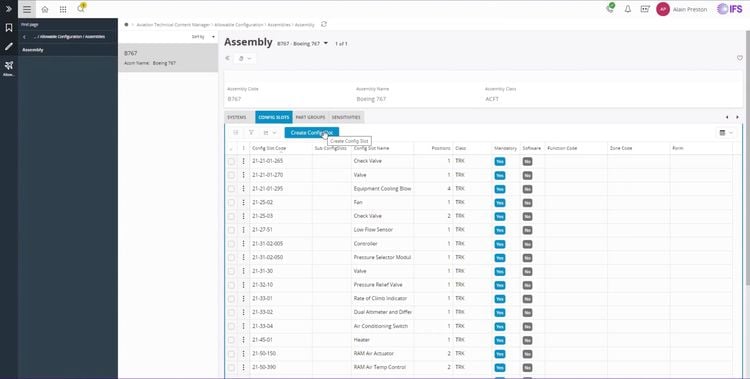
Shorten the Planning of Maintenance
If an airline can better plan its maintenance, its aircraft will be out of commission for a shorter amount of time. For a commercial airline, this can be the difference between handling more flights for paying customers and ultimately creating more revenue.
Aviation MRO software can help your business plan maintenance better and shorten the time needed for any needed work. Some aviation MRO solutions have been known to reduce the time it takes to produce a yearly production plan from three days to three hours.
MRO Cost Tracking For Accurate Quotations
Providing accurate quotes starts with proper cost tracking. When trying to win business with a customer, you’ll want to ensure any figures you give them or any bid you may be submitting clearly states the cost of each service. These costs are determined through processes your business can standardize.
Cost management is important for efficiently maintaining equipment and facilities outside of winning maintenance contracts. Most MRO software will integrate scheduled maintenance capabilities into your master production calendar.
You’ll want to ensure your business can cover the cost of each scheduled maintenance job, which starts with knowing how much it costs to provide routine maintenance. This includes the cost of any labor, utility costs for running power on machines, depreciation on machines, materials used during maintenance, and new parts that need to be ordered.
Billable Time and Expenses
During maintenance, shop staff must record their time worked and log it with the appropriate project/job. They’ll also record any inventory items used and any expenses incurred during the maintenance work (an example is the transportation costs to get to the job site). These hours will be used to calculate the cost being billed to the customer.
Time-tracking MRO tools will let all aviation MRO divisions record and analyze their workforce. Managers will monitor the time employees spend on productive work versus non-production time and be able to make better decisions about the best personnel fit for specific jobs.
MRO Invoicing
Invoicing is about labor tracking, production management, managing pricing structures, cost management, and providing real-time results.
Many invoices include charges for time spent working on various tasks. A proper invoice for maintenance, repair, and overhaul work will detail each maintenance activity. It will clearly describe the work completed and the hourly rate being charged for labor.
Some services may have variable labor rates if agreed upon during contract negotiations. This usually happens when certain maintenance work requires different skills, such as work that needs to be handled by both junior-level and senior-level staff members. Work involving a distinct classification of parts will also have different markups.
Modern aviation maintenance software will provide real-time invoicing, allowing the customer to see up-to-date changes to their account, including new charges that may have been added on.
The Rise of Mobile MRO Solutions
Depending on the size of the operation, going mobile can be an extremely cost-effective way of running your aviation MRO software. These solutions let maintenance workers use mobile devices (such as iPads) to monitor upcoming flight plans, the vehicles involved, pilot notifications and messages about issues, and scheduled maintenance schedules.
Mechanics can anticipate defects, which allows them to gather the necessary tools and parts ahead of schedule and be ready when the aircraft rolls into the shop. Mobile solutions also let the business go completely paperless, as it does not have to print documents, manuals, or procedures. They can even allow job completion to be noted via electronic signatures and notifications sent back to pilots.
MRO Pricing
Pricing for aviation MRO software varies widely based on company size, aircraft volume, and the depth of functionality required.
-
Small repair stations and parts shops using cloud-based and entry-level systems like Smart145, Corridor, and eMaint can expect prices starting around $100-$300 per user or roughly $5,000 to $15,000 annually for smaller teams.
-
Mid-size MRO operations with integrated inventory, compliance, and work order tracking, like OASES or Component Control, typically see pricing in the $20,000-$75,000 per year range, depending on user count and features desired.
-
Enterprise MROs and airlines implementing full suites like AMOS, IFS Cloud, and Ramco, often require custom pricing. These systems typically involve implementation fees and can cover more than just MRO functionality. Expect license costs to exceed $100,000 per year.


































